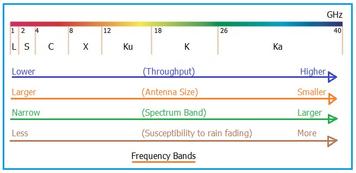Satellite Ground Station Basics
Advertisement
Satellite ground stations, also known as earth stations or hub stations, are designed to interface with orbiting satellites for various applications. They play a critical role in satellite networks, as they are responsible for recovering information from weak and noisy signals that have traveled from the satellite to Earth.
Ground station antennas typically vary in size depending on the application. For example, INTELSAT applications may require antennas with diameters of approximately 30 meters, while other satellites may use antennas with diameters of about 7.5 or 11.2 meters. Receiving DBS TV signals requires much smaller dish antennas, typically around 0.7 meters in diameter.
The following image depicts the typical modules found at an earth station:

Immediately after the antenna, a diplexer separates the uplink and downlink frequencies, directing them to the appropriate modules in the system. Downlink signals are passed to a Low Noise Amplifier (LNA), while uplink frequencies from the Power Amplifier (PA) are transmitted to the antenna without leaking into the LNA module.
Receiving Process at a Satellite Earth Station
Let’s examine the steps involved in the receiving process:
-
LNA Amplification: Received satellite signals are passed through an LNA, which amplifies the signal while adding minimal noise.
-
RF Power Division: The amplified signal from the LNA is then routed to a power divider, typically an RF power divider. The output of this divider is connected to RF down converters (DC).
-
Down Conversion: The down converter transforms the RF frequency (RF IN) to an Intermediate Frequency (IF) (IF OUT). These IF frequencies are then fed into demodulators (IF IN port of the modem).
-
Demodulation: The demodulator processes the modulated IF signal to extract the embedded information, which often exists in the form of a multiplexed signal. Therefore, a demultiplexer is needed.
-
Demultiplexing: The demultiplexer separates the signals and routes them based on their type. Voice signals are typically sent to an EPABX, while data signals are routed to a PC/LAN network.
-
Relaying (if necessary): If the information is not intended for that specific ground station, it must be relayed using a terrestrial network, a point-to-point microwave link, fiber optics, or even back to the satellite in mesh network configurations.
Transmission Process at a Satellite Earth Station
Now, let’s consider the transmission process:
-
Multiplexing: Various information signals, such as voice or data channels originating from exchanges, voice lines, or computers, are multiplexed using a Multiplexer.
-
Modulation: These multiplexed signals are then modulated using a modem. In typical network configurations, one modem is required for each VSAT station.
-
Up Conversion: The modulated IF signal is converted into a modulated RF signal using an RF Up converter (UC).
-
Combining: All the up-converted RF signals from multiple up converters are combined using an RF combiner.
-
Power Amplification: The output of the power combiner is fed to a Power Amplifier (PA) before the signal is transmitted to the antenna via a diplexer.
Carrier to Noise Ratio and Ground Station Specifications
The carrier-to-noise power ratio at the ground station is dependent on the G/T (Gain-to-Noise Temperature) ratio of the ground station antenna. Here, G represents the antenna gain, and T represents the system noise temperature.
G/T = G(dB) - 10 Log (T), where T is the temperature in Kelvin.
C/N = ((Pr G)/([k Ts B] G)) = (Pr/K Ts B)
Typical Satellite Earth Station Specifications
Here are some generic specifications for satellite earth stations:
Generic Specification:
- Uplink frequency: 14.437 GHz
- Downlink frequency: 11.637 GHz
Main Earth Station:
- Antenna Diameter: 7.5 meters
- G/T Ratio: 25.7 dB/K
Remote Earth Station:
- Antenna Diameter: 4.5 meters
- G/T Ratio: 19.7 dB/K
Advertisement
 RF
RF


